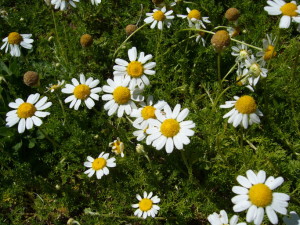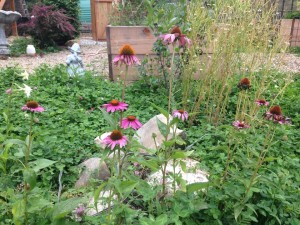Even though our gardens and pasture are still covered in about 3 feet of snow, I’m thinking about and planning for my spring garden. In just a few months the ground will be ready to support plant life. Now, if you live in a milder climate than North Idaho then your ground will be ready much sooner. Either way, this is a great time to plan, order seeds and get those starts going!
What herbs should you start with?
One of the questions I get asked frequently is what herbs would I recommend for a small medicinal herb garden or for someone just starting out so they don’t get overwhelmed. So that’s what I’m going to cover today. Of course, I don’t know everyone’s specifics. I will have to make a few assumptions – there will be plenty of sun, access to water, and the soil is healthy. One other important point is that these are herbs I believe allow for a beginner herbalist to begin treating their family with, they are also good for more advanced herbalists (for instance, I use chamomile in many preparations because it’s good for so many things). I’m hoping this will enable more and more individuals to grow their own “farmacy”!

Matricaria recutita – Chamomile
Like I mentioned before, I believe Chamomile (Matricaria recutita) to be one of the most important herbs in our home. I use it for upset stomach, trouble sleeping, calming skin irritations, colic, teething issues, anxiety, and more. It is one of those herbs that I could not do without.
Growing
Once it is growing (seed germination can be difficult) it can thrive in almost any type soil as long as it is well-draining, high clay content or shallow hard pan soil would not work here. It does require full sun, so don’t try to hide this in a corner! It’s PH requirement is also quite flexible growing well in soil as low as 5.6 up to 7.5. Sadly this is not a perennial plant which requires replanting each year. I left much of my flowers and allowed them to go to seed last fall hoping to see some new sprouts this year.
Uses: upset stomach, griping pain, IBS, calming skin irritations and reducing infection, colic, teething, hair rinse, anxiety, sleep aid
Soil: Well drained
Sun: Full sun but will tolerate a little shade
Annual

Echinacea purpurea– Echinacea (Purple Coneflower)
I’ve always been fond of “daisy” like flowers and Echinacea is no exception. Echinacea is not only beautiful to us, but attractive to pollinators. So if you’re looking to attract more pollinators to your garden, this is an herb you want to consider. Being a perennial, as long as you are giving it space to grow it will grace your garden year after year. It does not do well with “wet feet” but, once established it will tolerate drought and heat due to its deep tap root. The best way to propagate is by root cuttings in Autumn.
The flower isn’t as potent as the root
For medicinal purposes Echinacea flower can be used but will not be as strong as a preparation made from the root. If you are harvesting the flowers do it when the flowers are just starting to bloom, for the root harvest in the fall when all the energy has moved down (preferably after a frost or two). Don’t dig up the entire root, make sure to leave some to grow back in the spring. I left mine alone last year (besides clipping a few flowers) to allow it to propagate naturally.
Take it for a cold when…
In order for Echinacea to be helpful take it at the first sign of a cold, this is not a recommended herb to be used as a tonic. For internal use I recommend three preparations: infusion or tincture (flowers) or decoction (root). Make sure to follow directions for preserving herbs if you want to use it over the winter.
Uses: boost immunity
Soil: Well drained
Sun: Full sun but will tolerate a little shade
Water: water well until established, after that it will tolerate very dry
Melissa officinalis – Lemon Balm
First, a word of warning…lemon balm likes to grow and will expand in your garden if you do not keep it under control. This should not stop you from growing it, just understand you’ll need to cut it back and ‘tame’ it!
Lemon balm is my go to for two specific issues: anxiety and cold sores because of its anti-viral properties, but it is good for many other things as well: eczema, headache, insect bites, and wounds to name a few. As a culinary herb it adds a wonderful fresh, lemony-mint taste to any dish, (it’s especially good in fruit salad) and brews into a refreshing iced tea!
Clip it back and get a few harvests a year
In my garden, it is one of the fastest growing plants I have. If I see it getting a little sad looking, I simply cut it down and it magically rejuvenates it – basically It is another easy plant to grow and will grow prolifically if left alone! One way to control it is to clip it back several times in the summer and early fall to keep seeds from forming.
Unlike mint, it does not grow underground “runners” so it makes it easy to pull any unwanted plants that might get away from you. On a side note, this makes amazing fodder for your chickens and goats. When our chickens got into my herb garden they decimated my lemon balm, of course it grew back in a few weeks, but I was amazed at how much the chickens liked it. When I thin I just throw it over my fence and the chickens and goats fight for it!
Uses: Cold sores, anxiety, sleep aid, eczema, headaches, insect bites, wounds, colic, can help with ADHD
Soil: moist, rich and Well drained
Sun: Full sun
Water: does not tolerate drought very well
These are three great starter herbs if you are wanting to step into growing your own medicinal herb garden. I will cover three more in an upcoming post.




Leave a Reply
You must be logged in to post a comment.